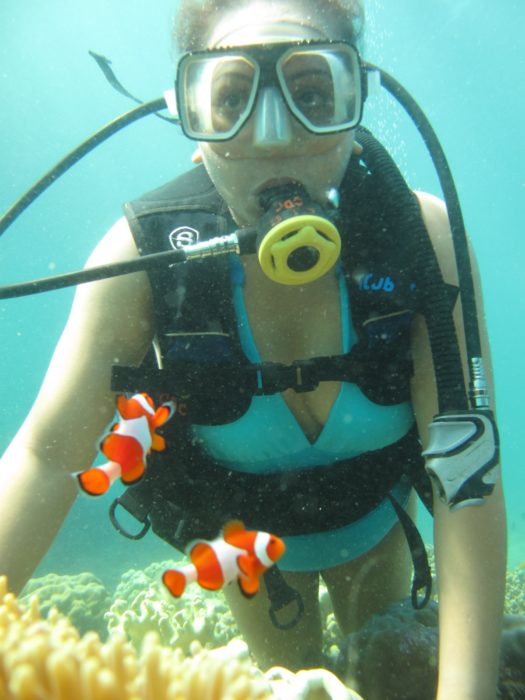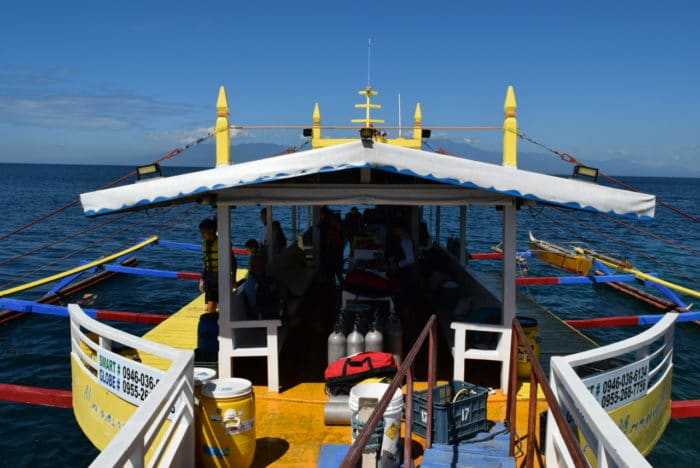I am currently taking a trip visiting friends and diving in the Philippines. One of my friends named Caren lives in Davao and was giving me a hard time because I never came to her hometown to visit. So this trip, I accepted her invitation. The day after I arrived, I started scouting out the diving and what I found was interesting. This is going to be more of a trip report than a dive site report.
Location
Davao City seldom appears on any list of Philippine dive destinations. There are dozens of very popular dive destination in the Philippines that attract divers from around the world. Most are a distance from major cities but still easy to travel to. Small towns and beachfront accommodations are common. Davao City in Southern Philippines does not fit that mold. Davao is one of the largest cities in the country with the Davao metro area having a population of over 1.6 million people. However, just a few minutes off the coast of Davao city are the small island of Talikud and the larger island of Samal. The full name of the island is the Island Garden City of Samal. There are about two dozen dive sites around these islands and more diving from small towns further north and south of the city.
The first major surprise I found is that while a year-round destination, most dive centers only have schedule dives on the weekends. One of the popular activities is island hopping. (Divers can also charter a dive vessel on any day. More on that later.) For a fare of around $8 a person, you can join one of these weekend sailings that generally go to Talikud Island. It is an eight-hour trip. It is about one hour to the island, two and a half hours at the first offshore stop, an hour and a half beach stop, a two hour offshore stop and an hour ride back. Divers with their own gear and dive buddy can join the outing and dive at the two offshore stops, just paying an additional $4 per tank. That means a three tank dive is just $20. While that was a shock, The price of their intro dives was even more so. The island hopping fare including an intro dive was also around $20.
The first thing that popped into my head was how safe would it be at such a low price. Social media has many horror stories of intro dives/discover dives that are poorly conducted and sometimes even dangerous. I looked on social media at some companies that were doing them, and they had good reviews and none that raised a red flag. So I suggest to Caren that I would treat her to island hopping and an intro dive.
Caren’s Intro Dive
It took a little persuasion to convince Caren to agree to the dive. She is a fair swimmer but does not like deep water. If she can see the bottom while she swims she is fine, it does not matter to her if the water is 4 feet (1.22 meters) or 15 feet (4.57 meters) deep, it just seeing what is below her. I got her to at least think about it, and we went to Carabao Dive Center to get details. While at the dive center, I told her to discuss her concerns with one of the dive staff. They had a private conversation off to the side and when she returned she was looking forward to it.
Saturday morning we packed a lunch and headed to Santa Ana Pier, to check in and join the Island Hopping. I decided not to dive, mostly, so I could keep an eye on the intro dive (I did dive the next day). The boat was large and certified for 40 passengers. There were about 25 passengers on board of which 6 were certified divers and 12 were intro divers. On the way to Talikud Island, the 12 intro divers were gathered and a briefing was given on the what would happen and the task they needed to learn. They also were taught a few basic hand signals. They were told that they would first practice breathing at the surface, then submerge slightly to practice clearing the mask. When they could do those comfortably, they would submerge to five to ten feet and explore around moving to a nearby slope and gradual go deeper if they wish. The maximum depth where they would be was 20 feet (ca. 6 meters). At the end of the briefing, they were separated into batches of three. Caren’s excitement won out, and she volunteers for the first batch. Two batches would dive at the first dive site and the other two at the second dive site.

When we arrived at the first dive site, the certified divers entered the water first. The location of the boat was in shallow water over a mostly sandy bottom with some coral. The intro divers were paired up with an instructor, it was a one on one encounter. Walking down some steps to water level she sat half in and half out of the water as a BCD and mask were fitted to her. Then it was off away from the boat to practice her skills. I would like to say that Caren took to it right away, but to be honest it took her about 10 minutes before she was ready to go deeper. The visibility was good, so I could see her progress. While in view, I could see that the instructor kept contact with her. When she was ready, they dropped to about 10 feet (ca. 3 meters) and a while later I lost sight of them as they went to a slope and the reef.
According to Caren later, they went to about 15 feet (4.57 meters) and stayed there. It was a depth she was comfortable with. Similar to her swimming practice, further, and she could not see the bottom. Since her return, she frequently talks about the reefs and the fish. One of her first comments was that now she understands the people who are always talking about protecting the ocean and the reefs.
The site where she did her intro dive is called the coral gardens. Most of the island hopping boats and there are many, make this their first call. They put many swimmers and snorkelers in the water but there are only a few boats that have an intro or certified divers. The certified divers will find that if they continue on the reef deeper than the intro divers, they will find good conditions and healthy corals. The certified divers said the water was a little cooler than normal being 80ºF. Visibility was about 50 feet (ca. 15 meters).
The second stop on the island hopping is a beach. The boats come to shallow waters and the passengers wade ashore. Many of them eat their lunch on the beach. On our trip, the next stop was at a site called Dayang. The certified divers started first, some went to slightly deeper water and did a slow drift dive towards another dive site Angel’s Cove. The last of the intro divers had their experience and after an hour we went and picked up the drift divers.
Generally, the first two sites are the same for most trips and most companies. The third site is often influenced by where the certified divers want to go. Still, the sites are on the west side of the island.

Chartered Dives
If you want to dive during the week, have your own group or just want to be away from the island hoppers, then the option of chartering your own boat may appeal to you. You can charter your own dive boat for around $120 for an 8-hour day. If you have your own gear, you just need to add $4 a tank. Also, after factoring in weather and tide conditions, you can select your own dive sites. There are over 25 dive sites including a couple of wrecks around Samal Island. Some are marine protected areas. On these sites you will not have the island hoppers and seldom will you have another dive boat on the same site.
These sites also offer a range of diving conditions and skill levels. There are many sites suitable for Open Water Divers while other sites may be better suited for experienced divers. There are some great deep dives and drift dives. Year round the water ranges from 80ºF to 85ºF and visibility can be more than 100 feet (ca. 30 meters).
While I would not consider Davao as a must do dive destination, it certainly does merit some attention if you are there or near there for other reasons. If your Philippine dive vacation has you arriving in at the Davao International airport, do yourself a favor and plan on a few days diving here.

